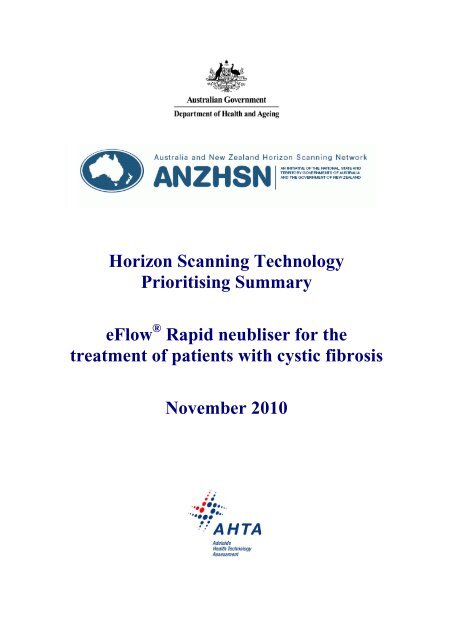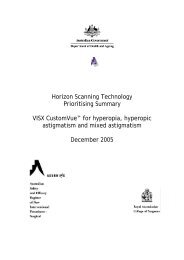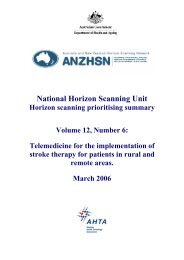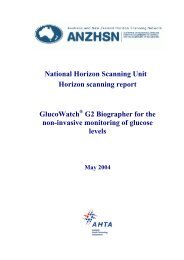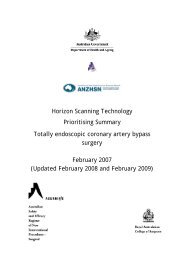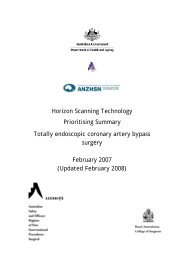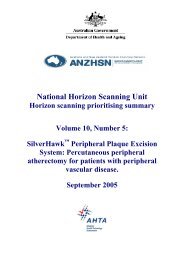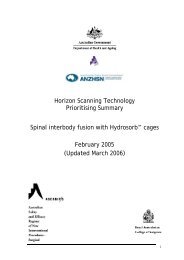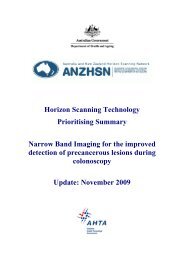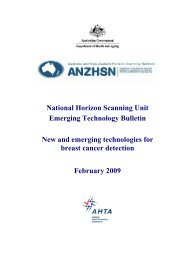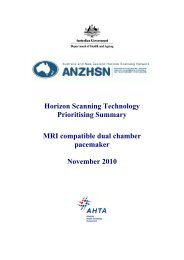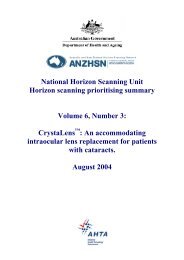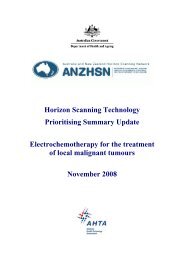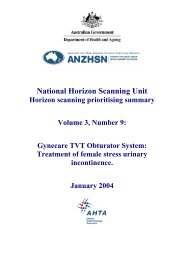eFlow® Rapid neubliser for the treatment of patients with cystic fibrosis
eFlow® Rapid neubliser for the treatment of patients with cystic fibrosis
eFlow® Rapid neubliser for the treatment of patients with cystic fibrosis
You also want an ePaper? Increase the reach of your titles
YUMPU automatically turns print PDFs into web optimized ePapers that Google loves.
Horizon Scanning TechnologyPrioritising SummaryeFlow ® <strong>Rapid</strong> <strong>neubliser</strong> <strong>for</strong> <strong>the</strong><strong>treatment</strong> <strong>of</strong> <strong>patients</strong> <strong>with</strong> <strong>cystic</strong> <strong>fibrosis</strong>November 2010
© Commonwealth <strong>of</strong> Australia 2010ISBNPublications Approval Number:This work is copyright. You may download, display, print and reproduce this material inunaltered <strong>for</strong>m only (retaining this notice) <strong>for</strong> your personal, non-commercial use or use<strong>with</strong>in your organisation. Apart from any use as permitted under <strong>the</strong> Copyright Act 1968, allo<strong>the</strong>r rights are reserved. Requests and inquiries concerning reproduction and rights should beaddressed to Commonwealth Copyright Administration, Attorney General’s Department,Robert Garran Offices, National Circuit, Canberra ACT 2600 or posted athttp://www.ag.gov.au/ccaElectronic copies can be obtained from http://www.horizonscanning.gov.auEnquiries about <strong>the</strong> content <strong>of</strong> <strong>the</strong> report should be directed to:HealthPACT SecretariatDepartment <strong>of</strong> Health and AgeingMDP 106GPO Box 9848Canberra ACT 2606AUSTRALIADISCLAIMER: This report is based on in<strong>for</strong>mation available at <strong>the</strong> time <strong>of</strong> research cannotbe expected to cover any developments arising from subsequent improvements healthtechnologies. This report is based on a limited literature search and is not a definitivestatement on <strong>the</strong> safety, effectiveness or cost-effectiveness <strong>of</strong> <strong>the</strong> health technology covered.The Commonwealth does not guarantee <strong>the</strong> accuracy, currency or completeness <strong>of</strong> <strong>the</strong>in<strong>for</strong>mation in this report. This report is not intended to be used as medical advice andintended to be used to diagnose, treat, cure or prevent any disease, nor should it be used<strong>the</strong>rapeutic purposes or as a substitute <strong>for</strong> a health pr<strong>of</strong>essional's advice. The Commonwealthdoes not accept any liability <strong>for</strong> any injury, loss or damage incurred by use <strong>of</strong> or reliance <strong>the</strong>in<strong>for</strong>mation.The production <strong>of</strong> this Horizon scanning prioritising summary was overseen by <strong>the</strong> HealthPolicy Advisory Committee on Technology (HealthPACT). HealthPACT comprisesrepresentatives from departments in all states and territories, <strong>the</strong> Australia and New Zealandgovernments; and ASERNIP-S. The Australian Health Ministers’ Advisory Council(AHMAC) supports HealthPACT through funding.This Horizon scanning prioritising summary was prepared by Linda Mundy and Pr<strong>of</strong>essorJanet Hiller from <strong>the</strong> National Horizon Scanning Unit, Adelaide Health TechnologyAssessment, Discipline <strong>of</strong> Public Health, School <strong>of</strong> Population Health and Clinical Practice,Mail Drop DX 650 545, University <strong>of</strong> Adelaide, Adelaide, SA, 5005.
PRIORITISING SUMMARYREGISTER ID:NAME OF TECHNOLOGY:PURPOSE AND TARGET GROUP:000485 (REFERRAL)EFLOW ® RAPID NEBULISERFOR THE TREATMENT OF PATIENTS WITHCYSTIC FIBROSISSTAGE OF DEVELOPMENT (IN AUSTRALIA): Yet to emerge Established Experimental Established but changedindication or modification <strong>of</strong>technique Investigational Should be taken out <strong>of</strong> useNearly establishedAUSTRALIAN THERAPEUTIC GOODS ADMINISTRATION APPROVAL Yes ARTG number149078 eFlow <strong>Rapid</strong>148661 eFlowNoNot applicableINTERNATIONAL UTILISATION:COUNTRYLEVEL OF USETrials Underway Limited Use Widely Diffusedor CompletedUnited States The Ne<strong>the</strong>rlandsFranceCanadaAustraliaIMPACT SUMMARY:Pari Pharma GmbH (Germany) provides <strong>the</strong> eFlow ® <strong>Rapid</strong> nebuliser (ARTG number149078) <strong>with</strong> <strong>the</strong> aim <strong>of</strong> delivering medication in an aerosol <strong>for</strong>m. The Pari eFlow ®(ARTG number 148661), although registered on <strong>the</strong> TGA is currently only in useunder clinical trial conditions using a specific pharmaceutical in conjunction <strong>with</strong> <strong>the</strong>nebuliser. The technology is available direct from <strong>the</strong> distributer, Technipro-PulmoMed Pty Ltd (New South Wales), primarily <strong>for</strong> <strong>patients</strong> <strong>with</strong> <strong>cystic</strong> <strong>fibrosis</strong> butmay be used <strong>for</strong> <strong>patients</strong> <strong>with</strong> an upper respiratory disease or severe asthma. The ParieFlow <strong>Rapid</strong> nebuliser: November 2010 1
eFlow ® <strong>Rapid</strong> nebuliser was approved <strong>for</strong> use by <strong>the</strong> United States FDA in 2004 and<strong>for</strong> European markets in 2005 (Rottier et al 2009).BACKGROUNDCystic <strong>fibrosis</strong> (CF) is a recessive genetic disorder caused by defects in <strong>the</strong> <strong>cystic</strong><strong>fibrosis</strong> transmembrane regulator (CTFR) gene. This genetic defect affects <strong>the</strong> glandswhich produce body secretions such as sweat, mucus and enzymes and although itmay affect many organs in <strong>the</strong> body, it primarily affects <strong>the</strong> lungs, pancreas, intestinesand <strong>the</strong> reproductive system. The CTFR gene is responsible <strong>for</strong> salt transport acrosscell membranes; as a consequence <strong>of</strong> <strong>the</strong> genetic defect, <strong>the</strong> mucus <strong>of</strong> people <strong>with</strong> CFis thick and viscous. When <strong>the</strong> thick and sticky mucus accumulates in <strong>the</strong> patient’slungs it becomes difficult to shift. CF <strong>patients</strong> develop a persistent cough to help clearaway mucus build-up in <strong>the</strong> lung. However, <strong>the</strong> mucus creates a breeding ground <strong>for</strong>bacteria and o<strong>the</strong>r infections and recurrent infections lead to irreversible lung tissuescarring (Al-Yaman et al 2002). There is no cure <strong>for</strong> CF and current <strong>the</strong>rapies aim toslow <strong>the</strong> progression <strong>of</strong> <strong>the</strong> disease. CF <strong>patients</strong> require lifelong intensive <strong>treatment</strong>including physio<strong>the</strong>rapy, antibiotic <strong>treatment</strong>, dietary control and digestive enzymecapsules. Patients <strong>with</strong> CF have a shortened life expectancy, <strong>with</strong> <strong>the</strong> predominantcause <strong>of</strong> death being loss <strong>of</strong> lung function, which begins in infancy and continuesthroughout <strong>the</strong> patient’s life (Cystic Fibrosis Australia 2009b).The Pari eFlow <strong>Rapid</strong> is a small (fits in <strong>the</strong> palm <strong>of</strong> your hand), light weight, portablenebuliser, which is capable <strong>of</strong> efficiently producing aerosols from liquid medications,such as antibiotics, via a vibrating, per<strong>for</strong>ated membrane (Figure 1).Medication reservoirAerosol headMouthpieceControl unit, on/<strong>of</strong>f buttonFigure 1The Pari eFlow ® <strong>Rapid</strong> nebuliser (printed <strong>with</strong> permission Pari Pharma)2 eFlow <strong>Rapid</strong> nebuliser: November 2010
The device is electronic and <strong>the</strong>re<strong>for</strong>e quieter than conventional compressor typenebulisers. The device can operate via a charged battery or mains supply. Thedimensions <strong>of</strong> <strong>the</strong> nebuliser and controller are 140 x 50 x 63mm and 117 x 42mm,respectively. The eFlow ® <strong>Rapid</strong> comes supplied <strong>with</strong> two aerosol heads allowing oneto be used whilst <strong>the</strong> o<strong>the</strong>r one is cleaned (PARI GmbH 2008). The eFlow ® <strong>Rapid</strong>produces aerosols <strong>with</strong> a very high density <strong>of</strong> an active drug <strong>with</strong> a defined dropletsize and results in shorter <strong>treatment</strong> times compared to than conventional nebulisers.The eFlow ® <strong>Rapid</strong> uses a vibrating mesh which determines <strong>the</strong> size <strong>of</strong> <strong>the</strong> inhaledparticles. It has been suggested that new nebuliser devices such as <strong>the</strong> eFlow ® <strong>Rapid</strong>increase <strong>the</strong> deposition <strong>of</strong> antibiotic <strong>the</strong>rapy into <strong>the</strong> lungs <strong>with</strong> improved patientoutcomes which ultimately result in increased patient compliance (Traini & Young2009).The principle underlying <strong>the</strong> eFlow ® <strong>Rapid</strong> is similar to that <strong>of</strong> an ink-jet printer, inthat <strong>the</strong> liquid medication is in contact <strong>with</strong> <strong>the</strong> micro-per<strong>for</strong>ated membrane, <strong>with</strong> <strong>the</strong>opposing side <strong>of</strong> <strong>the</strong> membrane open to <strong>the</strong> air. Around <strong>the</strong> membrane <strong>the</strong> pressure in<strong>the</strong> liquid is built up causing <strong>the</strong> fluid to be pushed through holes in <strong>the</strong> membrane inuni<strong>for</strong>m sized droplets, creating an aerosol. Acoustic pressure, generated by <strong>the</strong> highfrequencyvibration <strong>of</strong> <strong>the</strong> membrane, drives <strong>the</strong> aerosol outwards more efficientlythan a non-vibrating, passive membrane (Lass et al 2006).The majority <strong>of</strong> CF <strong>patients</strong> use antibiotic <strong>the</strong>rapy in some <strong>for</strong>m. In 2008, <strong>of</strong> <strong>the</strong> 95per cent <strong>of</strong> <strong>patients</strong> who had this in<strong>for</strong>mation recorded, 73 per cent had antibiotic<strong>the</strong>rapy. Oral antibiotics were used by 91 per cent <strong>of</strong> <strong>the</strong>se <strong>patients</strong> and <strong>of</strong> <strong>the</strong>se, 41per cent used oral antibiotics continuously ra<strong>the</strong>r than as needed. Inhaled antibioticswere used by 53 per cent <strong>of</strong> CF <strong>patients</strong> <strong>with</strong> 25 per cent using <strong>the</strong>m on a continuousbasis. Of <strong>the</strong> <strong>patients</strong> on <strong>the</strong> CF register, 288 received intravenous antibiotic <strong>the</strong>rapyei<strong>the</strong>r in <strong>the</strong> home (n=92) or in hospital and at home (n=196). Three or more courses<strong>of</strong> IV antibiotics were received by 49 <strong>patients</strong> (Cystic Fibrosis Australia 2010). O<strong>the</strong>r<strong>the</strong>rapies used include pancreatic enzymes, vitamin supplements, bronchodilators,long-term oxygen <strong>the</strong>rapy and non-invasive ventilation (Cystic Fibrosis Australia2010).Delivery <strong>of</strong> antibiotics via <strong>the</strong> inhaled route is advantageous <strong>for</strong> respiratory tractinfections as <strong>the</strong> lungs are directly targeted and <strong>the</strong> <strong>the</strong>rapeutic dose is lower than thatneeded via <strong>the</strong> oral or systemic routes <strong>of</strong> delivery. In addition, <strong>the</strong> inhaled route ismore suitable <strong>for</strong> some antibiotics which are not suitable <strong>for</strong> delivery via <strong>the</strong> oralroute due to poor bio-availability (Traini & Young 2009). Issues to be taken intoaccount when considering delivering a pharmaceutical via <strong>the</strong> inhaled route is that <strong>the</strong>properties <strong>of</strong> <strong>the</strong> drug must remain unchanged following <strong>the</strong> nebulisation process. Inaddition <strong>the</strong> pH and osmolarity <strong>of</strong> <strong>the</strong> nebulised solution need to be finely balanced toprevent coughing and bronchospasms in <strong>the</strong> patient. The aerosol droplets are usually1-5 µm in diameter and total <strong>treatment</strong> time should be less than 15 minutes (Hureauxet al 2009).eFlow <strong>Rapid</strong> nebuliser: November 2010 3
Consideration when choosing <strong>the</strong> type <strong>of</strong> device <strong>for</strong> <strong>the</strong> inhalation <strong>of</strong> medicationsmust be given to <strong>the</strong> particle mass (fraction <strong>of</strong> <strong>the</strong> nominal dose that leaves <strong>the</strong>inhaler), <strong>the</strong> inhaled mass (<strong>the</strong> fraction that is actually inhaled by <strong>the</strong> patient) whichmay differ dramatically between nebulisers and <strong>the</strong> respirable mass or <strong>the</strong> fine particlefraction, which is <strong>the</strong> proportion <strong>of</strong> <strong>the</strong> inhaled mass that is small enough (1-5µm) tobypass <strong>the</strong> upper airways and deposit in <strong>the</strong> lower airways (Heijerman et al 2009).Most nebulised drugs are ei<strong>the</strong>r solutions that contain a drug dissolved in saline or asuspension <strong>of</strong> a non-soluble drug. The use <strong>of</strong> aerosol delivery by means <strong>of</strong>nebulisation may increase <strong>the</strong> number <strong>of</strong> <strong>the</strong>rapeutic options available to CF <strong>patients</strong>as previously insoluble, but highly effective, drugs such as rifampicin may now besuccessfully used. A great number <strong>of</strong> clinical trials are currently underway or recentlycompleted aimed at identifying <strong>the</strong> most effective drugs <strong>for</strong> inhalation <strong>for</strong> <strong>the</strong><strong>treatment</strong> <strong>of</strong> CF. The eFlow ® (ra<strong>the</strong>r than <strong>the</strong> eFlow ® <strong>Rapid</strong>) is being assessed <strong>for</strong> use<strong>with</strong> a number <strong>of</strong> developmental antimicrobials including aztreonam, lev<strong>of</strong>loxacin andliposomal amikacin (Traini & Young 2009).CLINICAL NEED AND BURDEN OF DISEASEOne in twenty five <strong>of</strong> Caucasian Australians are carriers <strong>of</strong> <strong>the</strong> CF genetic defect. As<strong>the</strong> disease is recessive two copies <strong>of</strong> <strong>the</strong> defective gene are required, <strong>the</strong>re<strong>for</strong>e bothparents need to be carriers to produce a CF baby. Two carriers have a 25 per centchance <strong>of</strong> <strong>the</strong>ir child having CF, a 50 per cent chance <strong>of</strong> producing a carrier and a 25per cent chance <strong>of</strong> producing a normal child (Figure 2). Australia has a nationwideneonatal screening program that identifies approximately 95 per cent <strong>of</strong> CF babies. Inaddition, antenatal screening exists <strong>for</strong> subjects who have a CF family history or <strong>for</strong>partners <strong>of</strong> known CF <strong>patients</strong> (Cystic Fibrosis Australia 2009b).Figure 2The inheritance <strong>of</strong> <strong>the</strong> <strong>cystic</strong> <strong>fibrosis</strong> genetic defect4 eFlow <strong>Rapid</strong> nebuliser: November 2010
In 2008, <strong>the</strong>re were 2,843 persons living <strong>with</strong> CF in Australia, <strong>with</strong> a mean age <strong>of</strong>18.7 years (median 17 years). During that year, 73 infants were diagnosed <strong>with</strong> CF ata median age <strong>of</strong> 1.5 months, <strong>with</strong> 62 diagnosed at less than one year. Of <strong>the</strong> totalnumber <strong>of</strong> <strong>patients</strong> on <strong>the</strong> CF register, one in six individuals also had siblings <strong>with</strong>CF. During this same period, 19 individuals died from CF at a mean age <strong>of</strong> 30.2 years(Cystic Fibrosis Australia 2010). Gains from early screening and better managementinclude an improved life expectancy <strong>for</strong> people <strong>with</strong> <strong>cystic</strong> <strong>fibrosis</strong>. Comparisons <strong>of</strong>median age at death from <strong>cystic</strong> <strong>fibrosis</strong> in 10 countries (including Australia) showedan increase in <strong>the</strong> median age at death from eight years in 1974 to 21 years in 1994(Al-Yaman et al 2002). With <strong>the</strong> availability <strong>of</strong> improved <strong>treatment</strong> regimes, <strong>the</strong>average life expectancy <strong>of</strong> a patient <strong>with</strong> CF in Australia is now mid to late thirties<strong>with</strong> most <strong>patients</strong> expected to reach adulthood (Figure 3) (Cystic Fibrosis Australia2009b).Figure 3 Mean age <strong>of</strong> death from <strong>cystic</strong> <strong>fibrosis</strong> (based on data from (Cystic Fibrosis Australia 2010)Public hospital separation data <strong>for</strong> <strong>cystic</strong> <strong>fibrosis</strong> was difficult to obtain. Definitions<strong>for</strong> <strong>the</strong> Australian Refined Diagnosis Related Groups (AR-DRG) changed in 2004-05from version 4 to version 5. In 2004-05, <strong>the</strong>re were two AR-DRG numbers <strong>for</strong> <strong>cystic</strong><strong>fibrosis</strong>, E60A and E60B <strong>for</strong> <strong>cystic</strong> <strong>fibrosis</strong> <strong>with</strong> and <strong>with</strong>out catastrophic or severecomplication and/or comorbidities, respectively. During this period, <strong>for</strong> each <strong>of</strong> <strong>the</strong>seAR-DRGs <strong>the</strong>re were 1,985 and 991 public hospital separations, associated <strong>with</strong> anaverage length <strong>of</strong> stay <strong>of</strong> 12.3 and 7.5 days, respectively. The overwhelming number<strong>of</strong> <strong>the</strong>se separations occurred in <strong>patients</strong> less than 29 years <strong>of</strong> age (78-84%), <strong>with</strong> <strong>the</strong>peak <strong>of</strong> separations occurring in <strong>the</strong> 10-19 year age bracket (34-40%) (AIHW 2010).More recent data could not be obtained as E60A and B were not listed in version 5.0<strong>of</strong> <strong>the</strong> AR-DRG on <strong>the</strong> AIHW data site. During 2008, <strong>the</strong> average number <strong>of</strong> visits <strong>for</strong>eFlow <strong>Rapid</strong> nebuliser: November 2010 5
children and adolescents to a CF outpatient clinic was 4.8 (median 4) and <strong>for</strong> adults5.8 (median 5). According to data obtained from <strong>the</strong> CF register, 51.7 per cent <strong>of</strong> allCF <strong>patients</strong> were hospitalised at least once during 2008. Nearly two per cent <strong>of</strong><strong>patients</strong> were hospitalised more than six times in 2008. The majority <strong>of</strong>hospitalisations were <strong>for</strong> respiratory causes (Cystic Fibrosis Australia 2010).During 2008, 69 per cent <strong>of</strong> CF <strong>patients</strong> had at least two sputum samples analysed <strong>for</strong>infection. Of those <strong>patients</strong> tested, 53 per cent were positive <strong>for</strong> Pseudomonas, <strong>with</strong>38 per cent <strong>of</strong> <strong>the</strong>se positive <strong>for</strong> Pseudomonas aeruginosa. The prevalence <strong>of</strong>Pseudomonas infection is lower in children than in adults, young children <strong>with</strong> CF aremore likely to be positive <strong>for</strong> Staphylococcus aureus infection than adults. Haemophilusinfluenzae was also present in a high proportion <strong>of</strong> children, <strong>with</strong> 25 and 23 per cent <strong>of</strong>children aged 0-4 and 5-9 years infected, respectively. Thirteen per cent <strong>of</strong> children aged0-4 years were also infected <strong>with</strong> Escherichia coli (Cystic Fibrosis Australia 2010).In New Zealand, rates <strong>of</strong> CF are similar as to those in Australia <strong>with</strong> approximately one in25 New Zealanders <strong>of</strong> Caucasian origin being a carrier. CF is rare in Polynesians. Of allbirths in New Zealand, approximately one in 3000 to 3,500 infants will be born <strong>with</strong>CF. Currently <strong>the</strong>re are more than 400 children and adults living <strong>with</strong> CF in NewZealand (Cystic Fibrosis Association <strong>of</strong> New Zealand 2010). No o<strong>the</strong>r data from NewZealand could be identified.DIFFUSIONApproximately 5-600 eFlow ® <strong>Rapid</strong> nebulisers have been sold direct to <strong>patients</strong> inAustralia (personal communication Technipro-PulmoMed Pty Ltd).COMPARATORSThe main <strong>treatment</strong>s <strong>for</strong> CF <strong>patients</strong> aim to maintain lung function by <strong>the</strong> removal <strong>of</strong>mucus secretions from <strong>the</strong> lungs and to unblock airways. Physio<strong>the</strong>rapy is an integralpart <strong>of</strong> this <strong>treatment</strong> pathway <strong>with</strong> most CF <strong>patients</strong> undergoing 2-4 sessions per dayin <strong>the</strong> home environment. Techniques such as chest percussion, vibrations and o<strong>the</strong>rphysical manipulations are per<strong>for</strong>med <strong>with</strong> <strong>the</strong> patient required to be in specificpostures to facilitate mucus expulsion. Specific breathing techniques also play animportant part in CF <strong>the</strong>rapy. Controlled breathing <strong>with</strong> or <strong>with</strong>out specific devices isalso used to maintain lung function (Cystic Fibrosis Australia 2009b; Cystic FibrosisAustralia 2009a). Pharmaceutical <strong>treatment</strong> options may include <strong>the</strong> use <strong>of</strong>conventional nebulisers which use ei<strong>the</strong>r compression or jet propulsion to delivermedication, however <strong>the</strong>se devices have relatively poor antibiotic delivery efficiency(approximately 30%) (Traini & Young 2009). These nebulisers require a compressorwhich in turn requires ei<strong>the</strong>r a mains-operated power supply <strong>of</strong> a large battery and are<strong>the</strong>re<strong>for</strong>e relatively large, bulky and noisy in comparison to <strong>the</strong> vibrating membranenebulisers (Lass et al 2006).6 eFlow <strong>Rapid</strong> nebuliser: November 2010
A new generation nebuliser, <strong>the</strong> I-neb Adaptive Aerosol Delivery System (PhilipsRespironics Ltd), also employs a vibrating mesh, <strong>with</strong> <strong>the</strong> added advantage <strong>of</strong>s<strong>of</strong>tware which senses <strong>the</strong> patient’s breathing patterns and pulses <strong>the</strong> aerosol onlyduring inspiration (Dhand 2010).SAFETY AND EFFECTIVENESS ISSUESA recent published review did not identify any studies that compared <strong>the</strong> newvibrating membrane nebulisers to conventional compression nebulisers <strong>for</strong> <strong>the</strong>delivery <strong>of</strong> medication to CF <strong>patients</strong>. Although a large number <strong>of</strong> devices areavailable on <strong>the</strong> market, <strong>the</strong> FDA has taken <strong>the</strong> step to approve only <strong>the</strong> devices used<strong>with</strong> <strong>the</strong> drug combination that was used during clinical trials. That is, a device maybe approved <strong>for</strong> use <strong>with</strong> tobramycin following a clinical trial, but fur<strong>the</strong>r trials wouldneed to be conducted <strong>for</strong> that device to be used <strong>with</strong> ano<strong>the</strong>r antimicrobial such asaztreonam. This review also identified a lack <strong>of</strong> Phase III clinical trials comparing <strong>the</strong>clinical effectiveness <strong>of</strong> <strong>the</strong> delivery devices <strong>for</strong> <strong>the</strong> <strong>treatment</strong> <strong>of</strong> CF <strong>patients</strong>. Thisreview identified <strong>the</strong> following two studies by Rottier et al (2009) and Hubert et al(2009) as <strong>the</strong> only two studies which described <strong>the</strong> use <strong>of</strong> <strong>the</strong> eFlow ® <strong>Rapid</strong> nebuliser(Falagas et al 2010).In <strong>the</strong> small cross over study by Hubert et al (2009) compared <strong>the</strong> delivery <strong>of</strong> atobramycin (TOBI) solution <strong>for</strong> inhalation via <strong>the</strong> eFlow ® <strong>Rapid</strong> nebuliser comparedto <strong>the</strong> LC Plus nebuliser (level III-2 intervention evidence). CF <strong>patients</strong> ≥6 years(n=25) <strong>with</strong> chronic Pseudomonas aeruginosa infection were randomly assigned toreceive TOBI (300mg, or 6o mg/ml) twice daily <strong>for</strong> 15 days ei<strong>the</strong>r via <strong>the</strong> eFlow ®<strong>Rapid</strong> or <strong>the</strong> LC Plus device. After a one week free from inhaled TOBI, butcontinuing on <strong>with</strong> standard <strong>the</strong>rapy, <strong>the</strong> <strong>patients</strong> crossed-over and used <strong>the</strong> alternativedevice <strong>for</strong> 15 days. Only 22 <strong>patients</strong> could be included <strong>for</strong> pharmacokinetic evaluationon <strong>the</strong> basis <strong>of</strong> compliance criteria.The mean nebulisation times were significantly shorter <strong>for</strong> <strong>the</strong> eFlow ® <strong>Rapid</strong>compared to those obtained <strong>with</strong> <strong>the</strong> LC Plus on Day 1 (7.4 ± 1.7 vs 17.6 ± 4.0mins, p
number <strong>of</strong> <strong>patients</strong> and <strong>the</strong> short study period made it unlikely that this study hadenough power to detect any differences.Although no clinically significant bronchospasm event was reported during this study,19 and 16 <strong>patients</strong> reported mild to moderate adverse events associated <strong>with</strong> <strong>the</strong>inhalation <strong>of</strong> TOBI <strong>with</strong> <strong>the</strong> eFlow ® and <strong>the</strong> LC Plus device, respectively. Adverseevents included headache, cough, dyspnoea and abdominal pain, however none wereconsidered serious enough to discontinue <strong>treatment</strong> (Hubert et al 2009).The per<strong>for</strong>mance <strong>of</strong> <strong>the</strong> Pari eFlow ® <strong>Rapid</strong> nebuliser was assessed in a smallobservational study conducted by Rottier et al (2009) in <strong>the</strong> Ne<strong>the</strong>rlands (level IVintervention evidence). The effectiveness <strong>of</strong> <strong>the</strong> device in treating CF <strong>patients</strong> was notreported. Fifteen adult <strong>patients</strong> <strong>with</strong> CF who had been treated <strong>with</strong> tobramycin (TOBI)using <strong>the</strong> Pari LC Plus nebuliser plus Turboboy compressor were switched tousing <strong>the</strong> eFlow ® <strong>Rapid</strong> nebuliser to administer TOBI <strong>for</strong> six months (3 cycles <strong>of</strong> 28days TOBI <strong>treatment</strong>). TOBI is widely regarded as <strong>the</strong> most effective antibiotic totreat Pseudomonas aeruginosa infection. Devices were <strong>the</strong>n surrendered <strong>for</strong>assessment. A subgroup <strong>of</strong> eight <strong>of</strong> <strong>the</strong>se <strong>patients</strong> repeated this testing protocol <strong>for</strong> afur<strong>the</strong>r six months after fur<strong>the</strong>r instruction on <strong>the</strong> cleaning and care <strong>of</strong> <strong>the</strong> device. Ofinterest was patient care and maintenance <strong>of</strong> <strong>the</strong> device and its ability to <strong>the</strong>n deliver<strong>the</strong> appropriate <strong>the</strong>rapeutic dose <strong>of</strong> TOBI.All <strong>patients</strong> indicated that <strong>the</strong>y had maintained <strong>the</strong>ir eFlow ® devices according toinstructions, however <strong>the</strong> majority <strong>of</strong> devices were returned <strong>with</strong> polluted meshes.Fur<strong>the</strong>r cleaning instructions were issued during series II in an attempt to alleviate thisproblem, however <strong>the</strong> majority <strong>of</strong> eFlow ® devices in series II also were returned <strong>with</strong>polluted meshes, which would indicate that <strong>the</strong> timely replacement <strong>of</strong> <strong>the</strong> mesh isrequired to provide optimum drug delivery.The parameters <strong>of</strong> drug delivered by <strong>the</strong> new and used eFlow ® devices and <strong>the</strong> newand used LC Plus device are summarised in Table 1. The volume median diameter <strong>of</strong>TOBI delivered from a new eFlow ® is significantly higher (24%) than that deliveredby a new LC Plus (3.5 vs 2.8 µm, p < 0.05) but <strong>the</strong> relative span <strong>of</strong> <strong>the</strong> sizedistribution 1 was significantly narrower <strong>for</strong> <strong>the</strong> eFlow ® (1.3 vs 2.2, p < 0.05). Thetotal nebulisation time <strong>of</strong> <strong>the</strong> eFlow ® increased significantly <strong>with</strong> device use <strong>with</strong> atime <strong>of</strong> 6.7 minutes <strong>for</strong> a new device compared to 8.7 minutes <strong>for</strong> a used one(p
<strong>patients</strong> may have been <strong>of</strong> benefit. Early shut down <strong>of</strong> <strong>the</strong> device resulted in a reduceddosage <strong>of</strong> medication being delivered. Of a potential average TOBI dose <strong>of</strong> 5.3 grams,<strong>the</strong> used eFlow ® devices delivered between 1.15 (22%) and 4.21 grams (79%),compared to new devices which delivered between 3.67 (69%) and 4.02 grams (76%).By replacing <strong>the</strong> polluted mesh in <strong>the</strong> used devices nebuliser times and drug deliverydoses were normalised.Table 1Comparison <strong>of</strong> <strong>the</strong> parameters <strong>of</strong> delivered drug using new and used eFlow and LC Plus devicesDeviceVolume mediandiameter inmicrons (X50)(range)Relative span <strong>of</strong><strong>the</strong> sizedistribution(X90 – X50)/X50Delivered dose(gm drugsolution)(range)Totalnebulisationtime (min)(range)Average outputrate (g/min)eFlow, new 3.5 (3.3 - 3.7) 1.3 3.85 (3.67 – 4.02) 6.7 (5.5 – 8.0) 0.58eFlow, usedSeries 1eFlow, usedSeries 23.8 (3.3 - 4.3) 1.3 3.35 (1.65 – 4.21) 9.0 (5.5 – 10) 0.373.5 (2.8 – 4.0) 1.3 3.48 (1.15 – 4.09) 8.7 (6.5 – 10) 0.40LC Plus, new 2.8 (2.7 – 3.0) 2.2 3.44 (3.41 – 3.5) 6.9 (6.8 – 6.9) 0.50LV Plus used 3.3 (2.8 – 4.2) 2.5 4.19 (3.61 – 4.44) 13.0 (8.0 – 20.5) 0.32These results indicate that <strong>the</strong> eFlow ® device delivers an aerosol which contains largerdroplets <strong>of</strong> medication in a narrower size range (less variability) than <strong>the</strong> LC Plus,which should result in a greater proportion <strong>of</strong> <strong>the</strong> drug being deposited in <strong>the</strong> upperairways. Shorter nebulising times when using <strong>the</strong> eFlow ® <strong>Rapid</strong> nebuliser should alsoresult in greater patient compliance, however, no data were presented on <strong>the</strong>effectiveness <strong>of</strong> <strong>the</strong> two delivery devices in terms <strong>of</strong> patient symptoms. It is clear thatpatient compliance <strong>with</strong> cleaning practices is <strong>of</strong> importance to maintain <strong>the</strong>rapeuticlevels <strong>of</strong> drug delivery.COST IMPACTNo cost-effectiveness studies reporting on <strong>the</strong> use <strong>of</strong> <strong>the</strong> eFlow ® <strong>Rapid</strong> wereidentified. The Pari eFlow ® <strong>Rapid</strong> costs approximately $1,740, compared to $440 <strong>for</strong>a conventional nebuliser. The majority <strong>of</strong> <strong>the</strong> cost is borne by <strong>the</strong> patient <strong>with</strong> someprivate health insurance companies covering part <strong>of</strong> <strong>the</strong> cost (personal communicationTechnipro-PulmoMed Pty Ltd).ETHICAL, CULTURAL OR RELIGIOUS CONSIDERATIONSThe use <strong>of</strong> <strong>the</strong> correct type <strong>of</strong> nebuliser and medication may prolong <strong>the</strong> lifeexpectancy <strong>of</strong> <strong>patients</strong> <strong>with</strong> CF <strong>the</strong>re<strong>for</strong>e it is critically important to identify whichcombination <strong>of</strong> device and medication is effective <strong>for</strong> each individual patient.Consideration may have to be given to enable equal access to all <strong>treatment</strong> devicesregardless <strong>of</strong> cost.eFlow <strong>Rapid</strong> nebuliser: November 2010 9
OTHER ISSUESThere are at least 10 clinical trials currently underway or have recently beencompleted, all <strong>of</strong> which are more concerned <strong>with</strong> <strong>the</strong> effectiveness <strong>of</strong> <strong>the</strong>administration <strong>of</strong> pharmaceutical agents <strong>for</strong> <strong>the</strong> <strong>treatment</strong> <strong>of</strong> <strong>cystic</strong> <strong>fibrosis</strong> ra<strong>the</strong>r than<strong>the</strong> effectiveness <strong>of</strong> <strong>the</strong> Pari eFlow ® nebuliser itself The following five studies havebeen completed: <strong>the</strong> randomised, crossover trial Tobramycin Inhalation SolutionAdministered by eFlow <strong>Rapid</strong> Nebulizer: Scintigraphy Study <strong>for</strong> <strong>patients</strong> <strong>with</strong> <strong>cystic</strong><strong>fibrosis</strong> (n=12) (NCT ID: NCT00399945); <strong>the</strong> randomised, crossover trialTobramycin Administered by eFlow <strong>Rapid</strong> Nebulizer: Pharmacokinetic Study <strong>for</strong><strong>patients</strong> <strong>with</strong> <strong>cystic</strong> <strong>fibrosis</strong> (n=20) (NCT ID: NCT00420836); <strong>the</strong> crossover studyPharmacokinetic Evaluation <strong>of</strong> an 8 -Week Treatment With Inhaled Tobramycin <strong>for</strong>Pseudomonas Infections (n=50) (NCT ID: NCT00634192) completed August 2009,<strong>the</strong> randomised controlled trial Safety, Pharmacokinetic and Pharmacodynamic Study<strong>of</strong> MP-376 in Patients With Cystic Fibrosis (n=40) (NCT ID: NCT00503490)completed December 2007; and <strong>the</strong> cohort study (observational model) Safety,Tolerability and Pharmacokinetics <strong>of</strong> MP-376 Administered <strong>for</strong> 14 Days to StablePediatric (CF) Patients (n=27) (NCT ID: NCT00840333), completed December2009. One randomised controlled study, The Short Term Safety and Efficacy <strong>of</strong>Inhaled L-Arginine in Patients With Cystic Fibrosis, was listed as recruiting, althoughit was stated that <strong>the</strong> completion date <strong>of</strong> <strong>the</strong> study was May 2009 (NCT ID:NCT00405665). Four studies were listed as active but not yet recruiting: <strong>the</strong>randomised controlled trial MP-376 (Aeroquin, Lev<strong>of</strong>loxacin <strong>for</strong> Inhalation) inPatients With Cystic Fibrosis (n=261) (NCT ID: NCT01180634) to be completed byMay 2012; <strong>the</strong> randomised crossover trial Pharmacokinetic Study <strong>of</strong> Bramitob ®Administered <strong>for</strong> Inhalation by Pari eFlow ® vs Pari LC ® PLUS Nebulizer <strong>for</strong> <strong>patients</strong><strong>with</strong> <strong>cystic</strong> <strong>fibrosis</strong> (n=24) (NCT ID: NCT01116089) to be completed by February2011; <strong>the</strong> randomised controlled trial Aztreonam <strong>for</strong> Inhalation Solution (AZLI) vsTobramycin Inhalation Solution (TOBI ® ) in Patients With Cystic Fibrosis &Pseudomonas Aeruginosa (n=200) (NCT ID: NCT00757237) to be completed byNovember 2010; and <strong>the</strong> randomised controlled trial Safety and Efficacy Study <strong>of</strong>Aztreonam <strong>for</strong> Inhalation Solution (AZLI) in Patients With Cystic Fibrosis andChronic Burkholderia Species Infection (n=100) (NCT ID: NCT01059565) whichwas registered to begin in February 2010 (US National Institutes <strong>of</strong> Health)SUMMARY OF FINDINGSThere was a dearth <strong>of</strong> comparative evidence describing <strong>the</strong> use <strong>of</strong> <strong>the</strong> eFlow ®nebuliser device <strong>for</strong> <strong>the</strong> <strong>treatment</strong> <strong>of</strong> <strong>cystic</strong> <strong>fibrosis</strong> <strong>patients</strong>. Both <strong>of</strong> <strong>the</strong> includedstudies reported shorter nebulisation times in comparison to conventional compressornebulisers, which should translate into greater patient compliance and <strong>the</strong>re<strong>for</strong>eimproved <strong>the</strong>rapeutic outcomes. However, this conclusion cannot be supported by <strong>the</strong>10 eFlow <strong>Rapid</strong> nebuliser: November 2010
evidence included <strong>for</strong> assessment in this summary. Studies <strong>with</strong> long-term endpointsare required to confirm this speculation.Consideration should also be given to <strong>the</strong> large number <strong>of</strong> o<strong>the</strong>r nebulisation devicesthat are coming onto <strong>the</strong> market, including <strong>the</strong> eFlow ® . In addition, <strong>the</strong> safety andeffectiveness <strong>of</strong> <strong>the</strong> device needs to be considered when different pharmaceuticals areused.HEALTHPACT ASSESSMENT:Although only low level <strong>of</strong> evidence was available <strong>for</strong> inclusion in this assessment,<strong>the</strong> eFlow ® device shows potential <strong>for</strong> improved <strong>the</strong>rapeutic outcomes due to <strong>the</strong>associated shorter nebulisation times. Patient compliance <strong>with</strong> medication may play arole in <strong>the</strong> uptake <strong>of</strong> this technology. There are a number <strong>of</strong> clinical studies ei<strong>the</strong>rrecently completed or commenced which may provide more detailed in<strong>for</strong>mationregarding <strong>the</strong> effectiveness <strong>of</strong> this device. HealthPACT will await fur<strong>the</strong>r feedbackfrom clinicians regarding <strong>the</strong> effectiveness and expected uptake <strong>of</strong> this device.NUMBER OF INCLUDED STUDIESTotal number <strong>of</strong> studies 2Level III-2 intervention evidence 1Level IV intervention evidence 1REFERENCES:AIHW (2010). Separation, patient day and average length <strong>of</strong> stay statistics byprincipal diagnosis in ICD-10-AM, Australia, 1998-99 to 2004-05 [Internet].Australian Institute <strong>of</strong> Health and Welfare. Available from:http://d01.aihw.gov.au/cognos/cgi-bin/ppdscgi.exe?DC=Q&E=/AHS/pdx0708[Accessed 29th September].Al-Yaman, F., Bryant, M. & Sargeant, H. (2002). Australia's children: <strong>the</strong>ir healthand wellbeing 2002, Australian Institute <strong>of</strong> Health and Welfare Canberra, Availablefrom: http://www.aihw.gov.au/publications/phe/ac02/ac02.pdf.Cystic Fibrosis Association <strong>of</strong> New Zealand (2010). General In<strong>for</strong>mation aboutCystic Fibrosis [Internet]. Available from: http://www.cfnz.org.nz/about-<strong>cystic</strong><strong>fibrosis</strong>/[Accessed 4th October].Cystic Fibrosis Australia (2009a). [Internet]. Available from:http://www.<strong>cystic</strong><strong>fibrosis</strong>.org.au [Accessed 12th May].Cystic Fibrosis Australia (2009b). Understanding Cystic Fibrosis [Internet]. CysticFibrosis Australia. Available from:http://www.<strong>cystic</strong><strong>fibrosis</strong>.org.au/pdf/Understanding_CF.pdf [Accessed 12th May].Cystic Fibrosis Australia (2010). Cystic <strong>fibrosis</strong> in Australia 2008, Australian CysticFibrosis Data Registry, Available from:http://www.<strong>cystic</strong><strong>fibrosis</strong>.org.au/pdf/Cystic_Fibrosis_in_Australia_2008.pdf.Dhand, R. (2010). 'Intelligent nebulizers in <strong>the</strong> age <strong>of</strong> <strong>the</strong> Internet: The I-neb AdaptiveAerosol Delivery (AAD) system', J Aerosol Med Pulm Drug Deliv, 23 Suppl 1, iii-v.eFlow <strong>Rapid</strong> nebuliser: November 2010 11
Falagas, M. E., Michalopoulos, A. & Metaxas, E. I. (2010). 'Pulmonary drug deliverysystems <strong>for</strong> antimicrobial agents: facts and myths', International Journal <strong>of</strong>Antimicrobial Agents, 35 (2), 101-106.Heijerman, H., Westerman, E. et al (2009). 'Inhaled medication and inhalation devices<strong>for</strong> lung disease in <strong>patients</strong> <strong>with</strong> <strong>cystic</strong> <strong>fibrosis</strong>: A European consensus', Journal <strong>of</strong>Cystic Fibrosis, 8 (5), 295-315.Hubert, D., Leroy, S. et al (2009). 'Pharmacokinetics and safety <strong>of</strong> tobramycinadministered by <strong>the</strong> PARI eFlow rapid nebulizer in <strong>cystic</strong> <strong>fibrosis</strong>', J Cyst Fibros, 8(5), 332-337.Hureaux, J., Lagarce, F. et al (2009). 'Lipid nanocapsules: ready-to-use nanovectors<strong>for</strong> <strong>the</strong> aerosol delivery <strong>of</strong> paclitaxel', Eur J Pharm Biopharm, 73 (2), 239-246.Lass, J. S., Sant, A. & Knoch, M. (2006). 'New advances in aerosolised drug delivery:Vibrating membrane nebuliser technology', Expert Opinion on Drug Delivery, 3 (5),693-702.PARI GmbH (2008). Aerosol: Delivery <strong>with</strong> eFlow ® Technology [Internet]. Availablefrom: http://www.paripharma.com/technologies1.htm [Accessed 29th September].Rottier, B. L., van Erp, C. J. et al (2009). 'Changes in per<strong>for</strong>mance <strong>of</strong> <strong>the</strong> Pari eFlowrapid and Pari LC Plus during 6 months use by CF <strong>patients</strong>', J Aerosol Med PulmDrug Deliv, 22 (3), 263-269.Traini, D. & Young, P. M. (2009). 'Delivery <strong>of</strong> antibiotics to <strong>the</strong> respiratory tract: Anupdate', Expert Opinion on Drug Delivery, 6 (9), 897-905.SEARCH CRITERIA TO BE USED:Administration, InhalationAnti-Bacterial Agents/administration & dosage/*pharmacokineticsCross-Over StudiesCystic Fibrosis/*complicationsLung DiseasesNebulizers and VaporizersAerosolsCystic Fibrosis/*drug <strong>the</strong>rapyHEALTH PACT DECISION: Horizon Scanning Report Full Health Technology Assessment Monitor Archive Refer Decision pendingPRIORITY RATING High Medium Low12 eFlow <strong>Rapid</strong> nebuliser: November 2010


